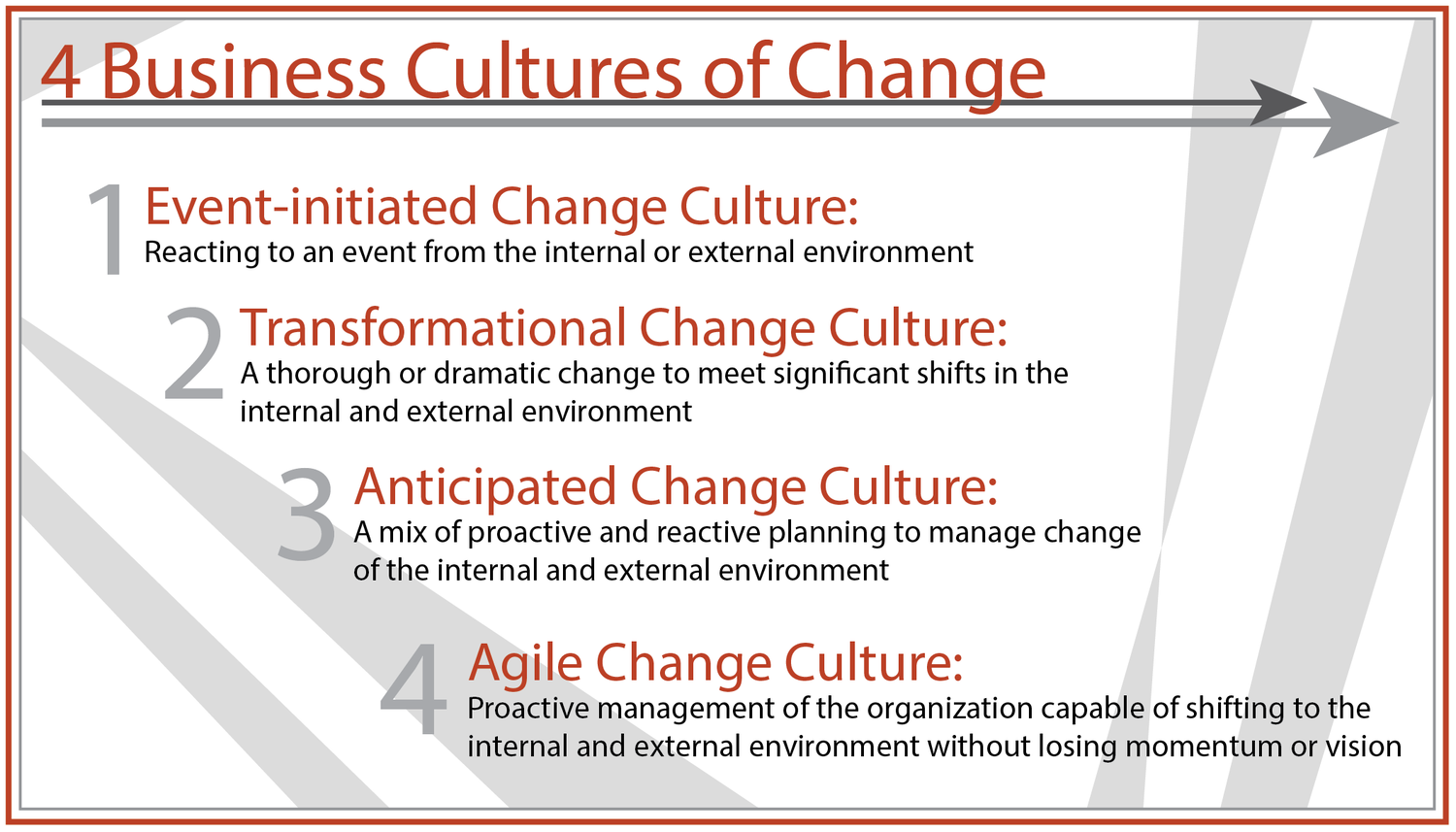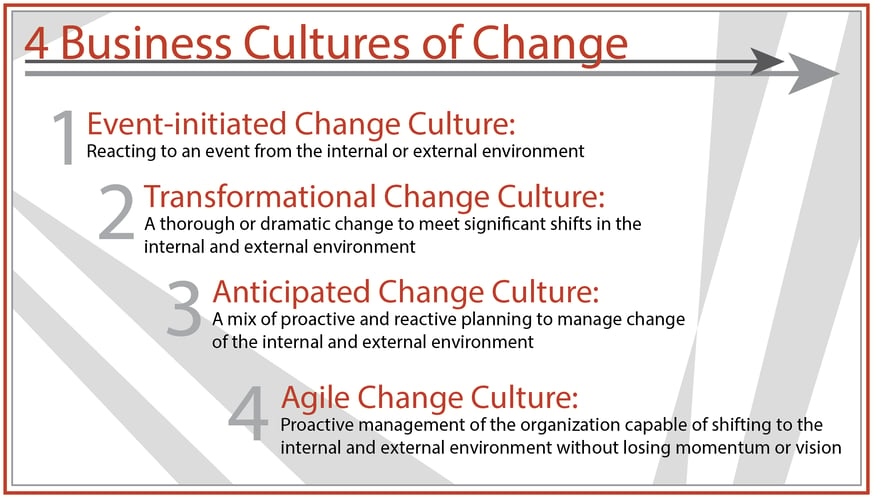3 min read
The Traditionalist and Change
In today's workplaces, having different generations can be both challenging and beneficial, especially when managing big changes like an ERP...

It is incredible how much information you can find on the topic of “change” within the business world, and rightfully so in this day and age of rapid advancements in technology, strategy, and external environmental factors.
Are you one of those leaders who would say something to the effect; “Ah, give it a year. It will all change again, so why do anything now? We can make more changes at once if we wait.” If so, you may be placing your organization or department at risk by delaying the changes required to support shifts within the internal/external environments.
How high a risk this is depends on your organization/ department’s business culture of change (see figure 1) as compared to your competition’s. The closer your competition is to agile change, the higher the risk is that you are making a mistake in delaying change. In a previous post, we discussed the business-transformation-defined. This happens most successfully with the right change culture. Therefore I’ve reviewed the following cultures. As you read these, consider which reflects your organization/department.

Basically, as the title reads, change is not initiated until an event requires a change to be made. Within this culture, the status quo is the rule of thumb. There is a strong level of anxiety present for many people within this culture, and they keep the status quo.
They may even draw blood if you hint at a change in their world. The carrot-and-stick approach to change is the most used tool in this culture and is difficult to maintain over a long period of time. A behavior may have been changed in the short term, but the beliefs and attitudes of the status quo mindset continue to live on. A dump truck of data proving that change is for the better will only strengthen their beliefs.
If event-initiated change is where you would score yourself, I would recommend developing a plan to recreate the changing culture no matter where your competition is positioned. The move is either, at most, a move to keep up with your competition or, at best, a step in the direction of beating your competition.
A thorough or dramatic change is required to meet significant shifts in the internal and external environment. Normally I would say this is required across the entire organization, but it could be across a large department. Regardless, the transformation will affect cross-functional department links. The best-case situation in this culture is an organization-wide transformation involving all cross-functional departments. It is the best way to have everyone marching in the same direction at the same pace.
Typical transformational change cultures are largely structured process-driven change initiatives. These initiatives are driven by strong leaders who do not know the word “failure.” Varying levels of employee status quo beliefs and high levels of anxiety still exist within the organization. The structured change process helps to change employee behavior first and the shift in beliefs follows. In this culture, many employees have come to realize that change will be necessary to compete as they are currently struggling to remain a viable business.
In this business culture, there is a mix of proactive and reactive planning to manage change from the internal and external environment. Within this culture, the employees fully understand it is in their best interest to welcome change and even try to create change in anticipation of an event. Leaders at various levels have developed forward-thinking structured and unstructured tools to anticipate change in internal and external environments. With support from the employees, shifts in the business are made to meet almost all changes. The large dramatic changes which require a transformation have been partially or fully anticipated and reduced to smaller, manageable changes. The organization will still trip over itself from time to time cross-functionally, missing an opportunity requiring a reactive change. If you are a football fan, this is similar to calling for a pass play, anticipating the defense will protect against the run. Instead, the defense sends in a blitz to stop the pass play. Hopefully, this analogy helps you picture this type of change culture unless, like me, you do not watch football (1989 Monday night game and my favorite team choked again- “That’s IT!”).
This is the ideal culture for change – what all businesses strive to be (or should be in a perfect world). Within the business organization, the leadership and managers in an agile change culture are capable of shifting to the internal and external environment without losing momentum or vision. Cross-functionally the technologies, processes, and people are in a position to easily shift in almost any direction that a change is required.
Employee resistance does not exist, and change requirements are actually anticipated, monitored, and initiated from the bottom up. Back to football… Picture an offense that is capable of changing the play from a run to a pass while the play is running. All the players are capable of reacting as one to any internal or external changes. To do this while the play is running would be more like the “ideal state” of the agile culture. Successfully calling an audible play change at the line of scrimmage a high majority of the time would be a trait of a winning football team.
Change is a constant in today’s environment and may be exponentially faster in the future. But don’t let this change get you down. As a leader, the bottom line is that you must embrace change and make the audible change on the field while the play is moving. Develop and perfect a mature level change culture and who could stop you?

3 min read
In today's workplaces, having different generations can be both challenging and beneficial, especially when managing big changes like an ERP...
.png)
4 min read
ERP (Enterprise Resource Planning) discussions include Business Transformation at an increasing rate. Transformation may sound impressive – or...

Supply chain segmentation is a practice in the field of supply chain management that refers to the process of breaking down a company's entire supply...